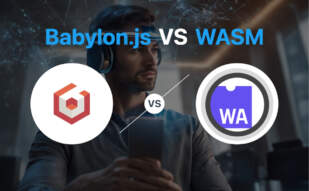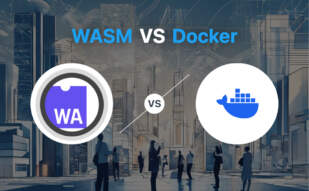When pitting WASM against JavaScript, it boils down to the use-case: if ultra-performance and near-native speeds are your goals, especially for graphics-heavy applications such as VR/AR, video editing, or 3D gaming, opt for WebAssembly (WASM). However, for web page interactivity and dynamic content creation, JavaScript remains the tried-and-true choice.

Key Differences Between WASM and JavaScript
- WebAssembly enhances performance significantly and supports low-level binary format for near-native speed, ideal for intensive uses such as VR/AR, graphics-rich gaming, and heavy computation.
- JavaScript excels at web page interactivity, enabling dynamic content creation and client-side interactions.
- While WASM offers superior memory safety and reduces vulnerability attack surface, JavaScript is more dynamic and widely adopted, powering 97% of all websites.
- WASM supports multiple languages (C, C++, Rust, Go) and allows sharing libraries regardless of the language, while JavaScript, tied to ECMAScript standard, primarily functions in browser context.
| Comparison | WebAssembly (WASM) | JavaScript |
|---|---|---|
| Established | 2017 | 1995 |
| Standard Established by | W3C | ECMAScript |
| Use Case | Video editing, 3D games, VR/AR, P2P services, Scientific simulations | Web page interactivity, Browsers, HTML content creation |
| Language Compatibility | C, C++, Rust, Go | Self-contained, also used in AJAX, CommonJS Modules |
| Security | Reduced vulnerability attack surface, better memory safety, obscured code, sandboxing | Features lacking for security reasons, no multi-threading/multiprocessor capabilities |
| Performance | Near-native speed, ideal for intensive use cases like VR, AR | Depends on effective use of JavaScript’s object-oriented capabilities |
| Portability | Can run across different containers, Kubernetes clusters, devices, multicloud environments | Primarily for web and browser, but can be used outside with Node.js |
| Encoding | Files in .wasm format, low-level binary instructions | Interpreted language |
What Is WebAssembly and Who’s It For?
WebAssembly, known as WASM, is a binary instruction format developed as a W3C standard in 2019. This cutting-edge technology aids in enhancing website performance and capabilities extensively by employing a low-level binary format, running in all major browsers. WebAssembly is primarily intended for developers aiming to navigate performance issues in more intensive use cases such as AR, VR, image or video editing, offering near-native speed and a significant usage experience.
Application developers, especially those working with video editing, 3D games, augmented reality, scientific simulations, and P2P services, benefit the most from this technology. WebAssembly supports a host of languages, streamlining the coding process for frontend developers working in C, C++, Rust, Python, or Go.

Pros of WebAssembly
- High-speed execution and efficiency
- Enhances developer productivity
- Strong memory safety reducing vulnerability attack surface
- Supports a wide range of languages
Cons of WebAssembly
- Being a low-level binary format, it may require time to grasp
- Has a limited set of instructions
- Has a learning curve for beginners unfamiliar with binary formats
What Is JavaScript and Who’s It For?
JavaScript is a dynamic and object-oriented computer programming language that is lightweight and primarily used for web page interactivity. First introduced as LiveScript in Netscape 2.0 in 1995, JavaScript allows client-side scripts to interact with users, controlling browser behavior and creating dynamic HTML content. It is created for developers to create network-centric applications efficiently.
JavaScript finds its application in diverse fields and platforms like Node.js for server-side usage, while libraries like jQuery, AngularJS, and ReactJS push its use in AJAX-based web development. 97% of websites, including tech giants like Facebook and YouTube, employ JavaScript for seamless user interaction and feedback delivery.

Pros of JavaScript
- Enables creation of dynamic and interactive web pages
- Allows immediate feedback delivery to users
- Reduces server interaction through client-side validation
Cons of JavaScript
- Limited features owing to security concerns
- Does not enable multithreading or multiprocessing capabilities
- Can become complex when handling larger applications
WASM vs JavaScript: Pricing
Both WebAssembly (WASM) and JavaScript are freely available for developers to use, with no direct costs associated.
WebAssembly (WASM)
As a web development standard established by the World Wide Web Consortium (W3C), WASM is free of cost. Being designed for browser compatibility, it comes at no additional pricing for its use. Developers can use it to enhance their web apps and optimise performance. The cost factor is essentially attached to the human resources, knowledge and expertise required in leveraging The WASM technology.
JavaScript
JavaScript, one of the pillars of modern web development, has always been free-to-use. Its open-source nature encourages web developers to utilise the scripting language without any monetary constraints. Since JavaScript is client-side and runs directly in browser environments, no purchasing or licensing costs are associated. However, the overall expense in JavaScript development would include the programmers’ expertise, resources, and tooling to create, debug, and manage JavaScript code.
Code Examples for WASM & JavaScript
WASM
The following WASM code snippet depicts the process of creating a simple Fibonacci function. Before diving in, ensure that you have the Emscripten toolkit installed to compile the C code into WebAssembly.
#include <emscripten emscripten.h="">
EMSCRIPTEN_KEEPALIVE
int fib(int n) {
if (n <= 0)
return 0;
else if (n == 1)
return 1;
else
return fib(n-1) + fib(n-2);
}
</emscripten>JavaScript
This JavaScript snippet showcases how to call the WebAssembly Fibonacci function defined above. It includes loading the WASM module and then invoking the function. Make sure your server environment supports serving WebAssembly files correctly before setting out with this example.
fetch('wasm/fib.wasm')
.then(response => response.arrayBuffer())
.then(bytes => WebAssembly.instantiate(bytes))
.then(results => {
const { fib } = results.instance.exports; // import the fib function
let n = 10;
console.log(`The ${n}th number in the Fibonacci sequence is ${fib(n)}.`);
})
.catch(console.error); These are stepping stones for venturing deeper into the world of JavaScript and WASM. They introduce you to various crucial aspects, such as Emscripten, EMSCRIPTEN_KEEPALIVE, WebAssembly.instantiate, and more.
The Final Showdown: WASM or JavaScript?
The battlefield: WASM and JavaScript. Two technologies, each with a unique set of strengths. The stand-off? Inevitable. Now, let’s drill into which reigns supreme for different subsets of our tech community.
Gaming & AR/VR Developers
When it comes to gaming and AR/VR development, WebAssembly (WASM) trumps JavaScript hands down. WASM’s high-performance execution, coupled with its compatibility with languages like C++ and Rust, is a magnet for developers creating intensive applications. WASM eliminates buffering complexities, supports in-browser C/C++, and makes AR/VR programming a seamless feat. A bonus: its binary format is a natural fit for 3D games and virtual/augmented reality applications. WASM is your ally here, gamers and AR/VR mavens.

Developers Seeking Superior Performance and Portability
Granted, JavaScript is lightweight and dynamic, but it can’t keep pace with WebAssembly’s significant performance gains and near-native speed. WASM’s combination of high speed, efficiency, portability, and sandboxing is unmatched. Language lovers: you can wield Rust, Go, C++, and even Python here. WASM even works magic on serverless environments, effectively solving adoption issues. Performance seekers, board the WASM bandwagon.

Web Developers for Cutting-Edge Interactive Sites
It’s undeniable: JavaScript ruled the roost where interactivity was concerned. Whilst it’s adept for creating dynamic web pages and has that convivial relationship with HTML, WASM is stealing the limelight. With WASM, developers can generate high-performance functions in web environments like never before. For sophisticated applications beyond JavaScript’s comfort zone, WASM is the undisputed victor. Web developers, it’s time to broaden your horizons with WASM.

Troops Fighting for Memory Safety
For fortresses requiring robust security, WASM’s strong typed variables are harder to exploit than JavaScript’s dynamic ones. WASM’s now got your back against common vulnerabilities like buffer overflows, by providing better memory safety and reducing the attack surface. In the battle for memory safety and security, WASM raises the victory flag.

When it comes to the WASM vs. JavaScript debate, the verdict leans towards WASM for gaming, AR/VR, and high-performance applications, whereas JavaScript may still be practical for simpler interactive uses. However, with WASM on rise, it’s clear that JavaScript may no longer hold the crown.
Logan Bellbrook
Content writer @ Aircada with a knack for nature & AR/VR/XR. Blogging the intersection of tech & terrain.





